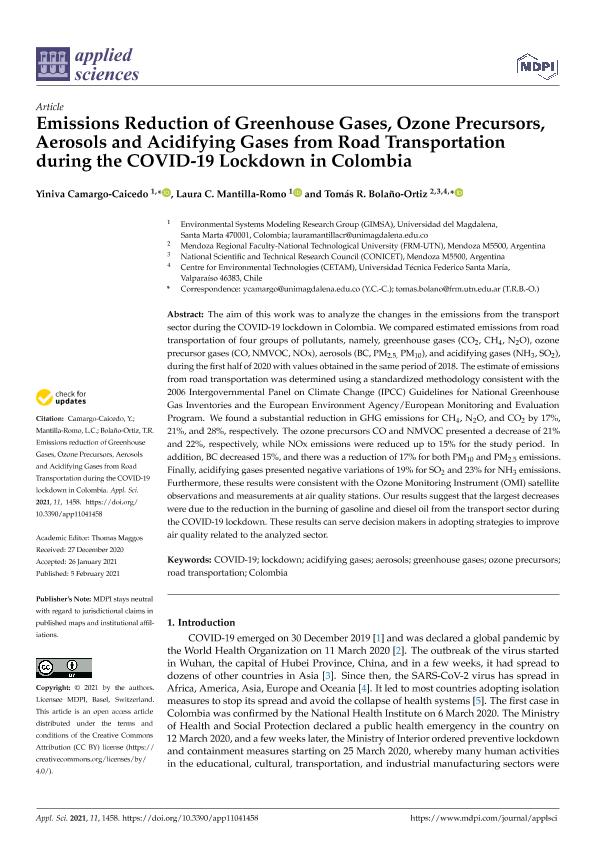Mostrar el registro sencillo del ítem
dc.contributor.author
Camargo Caicedo, Yiniva

dc.contributor.author
Mantilla Romo, Laura C.
dc.contributor.author
Bolaño Ortiz, Tomas Rafael

dc.date.available
2021-06-15T12:35:48Z
dc.date.issued
2021-02
dc.identifier.citation
Camargo Caicedo, Yiniva; Mantilla Romo, Laura C.; Bolaño Ortiz, Tomas Rafael; Emissions reduction of greenhouse gases, ozone precursors, aerosols and acidifying gases from road transportation during the COVID-19 lockdown in Colombia; Molecular Diversity Preservation International; Applied Sciences; 11; 4; 2-2021; 1-18
dc.identifier.issn
2076-3417
dc.identifier.uri
http://hdl.handle.net/11336/133867
dc.description.abstract
The aim of this work was to analyze the changes in the emissions from the transport sector during the COVID-19 lockdown in Colombia. We compared estimated emissions from road transportation of four groups of pollutants, namely, greenhouse gases (CO2, CH4, N2O), ozone precursor gases (CO, NMVOC, NOx), aerosols (BC, PM2.5, PM10), and acidifying gases (NH3, SO2), during the first half of 2020 with values obtained in the same period of 2018. The estimate of emissions from road transportation was determined using a standardized methodology consistent with the 2006 Intergovernmental Panel on Climate Change (IPCC) Guidelines for National Greenhouse Gas Inventories and the European Environment Agency/European Monitoring and Evaluation Program. We found a substantial reduction in GHG emissions for CH4, N2O, and CO2 by 17%, 21%, and 28%, respectively. The ozone precursors CO and NMVOC presented a decrease of 21% and 22%, respectively, while NOx emissions were reduced up to 15% for the study period. In addition, BC decreased 15%, and there was a reduction of 17% for both PM10 and PM2.5 emissions. Finally, acidifying gases presented negative variations of 19% for SO2 and 23% for NH3 emissions. Furthermore, these results were consistent with the Ozone Monitoring Instrument (OMI) satellite observations and measurements at air quality stations. Our results suggest that the largest decreases were due to the reduction in the burning of gasoline and diesel oil from the transport sector during the COVID-19 lockdown. These results can serve decision makers in adopting strategies to improve air quality related to the analyzed sector.
dc.format
application/pdf
dc.language.iso
eng
dc.publisher
Molecular Diversity Preservation International

dc.rights
info:eu-repo/semantics/openAccess
dc.rights.uri
https://creativecommons.org/licenses/by-nc-sa/2.5/ar/
dc.subject
ACIDIFYING GASES
dc.subject
AEROSOLS
dc.subject
COLOMBIA
dc.subject
COVID-19
dc.subject
GREENHOUSE GASES
dc.subject
LOCKDOWN
dc.subject
OZONE PRECURSORS
dc.subject
ROAD TRANSPORTATION
dc.subject.classification
Otras Ciencias de la Tierra y relacionadas con el Medio Ambiente

dc.subject.classification
Ciencias de la Tierra y relacionadas con el Medio Ambiente

dc.subject.classification
CIENCIAS NATURALES Y EXACTAS

dc.title
Emissions reduction of greenhouse gases, ozone precursors, aerosols and acidifying gases from road transportation during the COVID-19 lockdown in Colombia
dc.type
info:eu-repo/semantics/article
dc.type
info:ar-repo/semantics/artículo
dc.type
info:eu-repo/semantics/publishedVersion
dc.date.updated
2021-06-14T15:10:53Z
dc.journal.volume
11
dc.journal.number
4
dc.journal.pagination
1-18
dc.journal.pais
Suiza

dc.description.fil
Fil: Camargo Caicedo, Yiniva. Universidad del Magdalena; Colombia
dc.description.fil
Fil: Mantilla Romo, Laura C.. Universidad del Magdalena; Colombia
dc.description.fil
Fil: Bolaño Ortiz, Tomas Rafael. Universidad Tecnológica Nacional; Argentina. Universidad Tecnica Federico Santa Maria; Chile. Consejo Nacional de Investigaciones Científicas y Técnicas. Centro Científico Tecnológico Conicet - Mendoza; Argentina
dc.journal.title
Applied Sciences
dc.relation.alternativeid
info:eu-repo/semantics/altIdentifier/url/https://www.mdpi.com/2076-3417/11/4/1458
dc.relation.alternativeid
info:eu-repo/semantics/altIdentifier/doi/http://dx.doi.org/10.3390/app11041458
Archivos asociados
